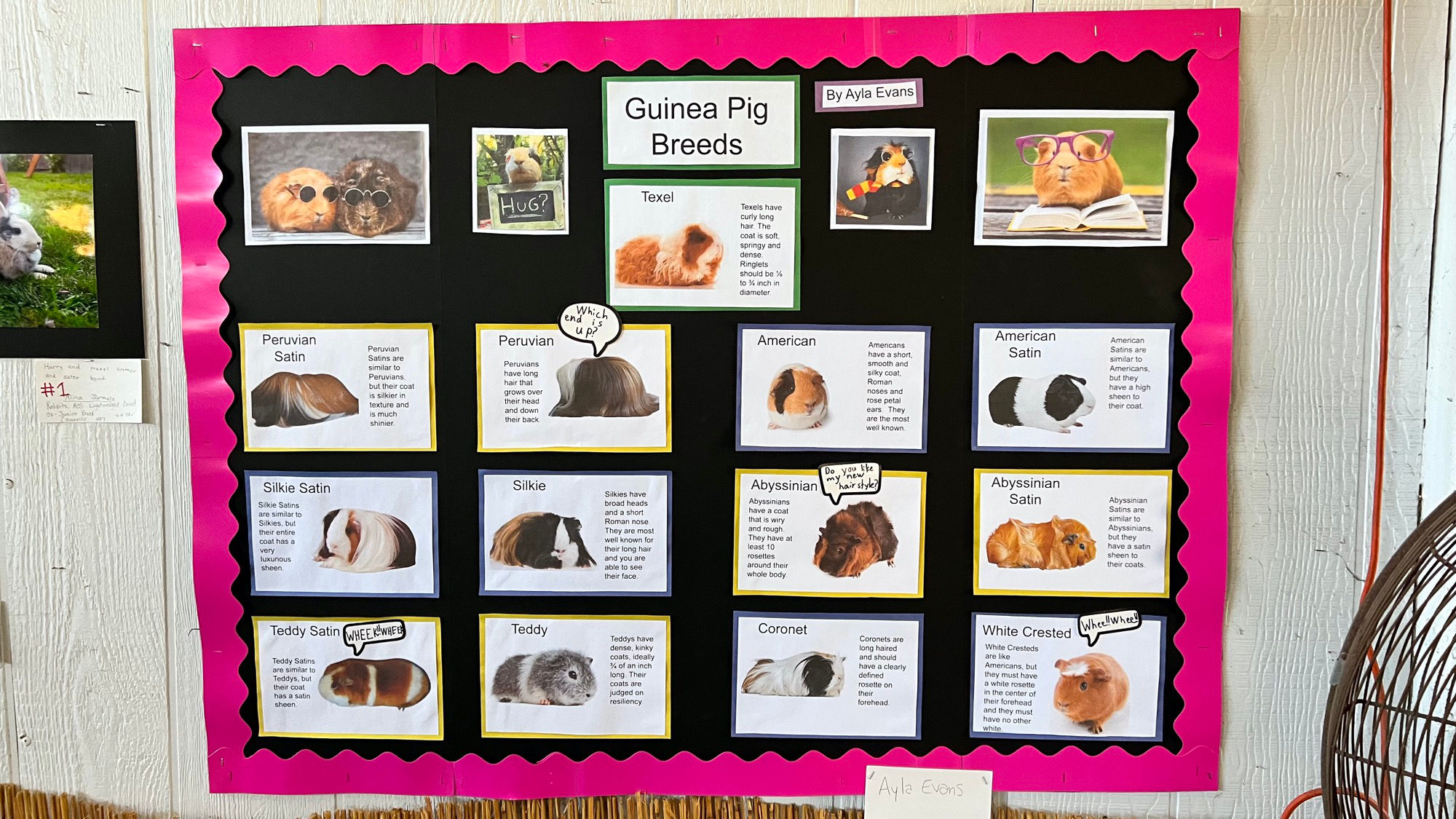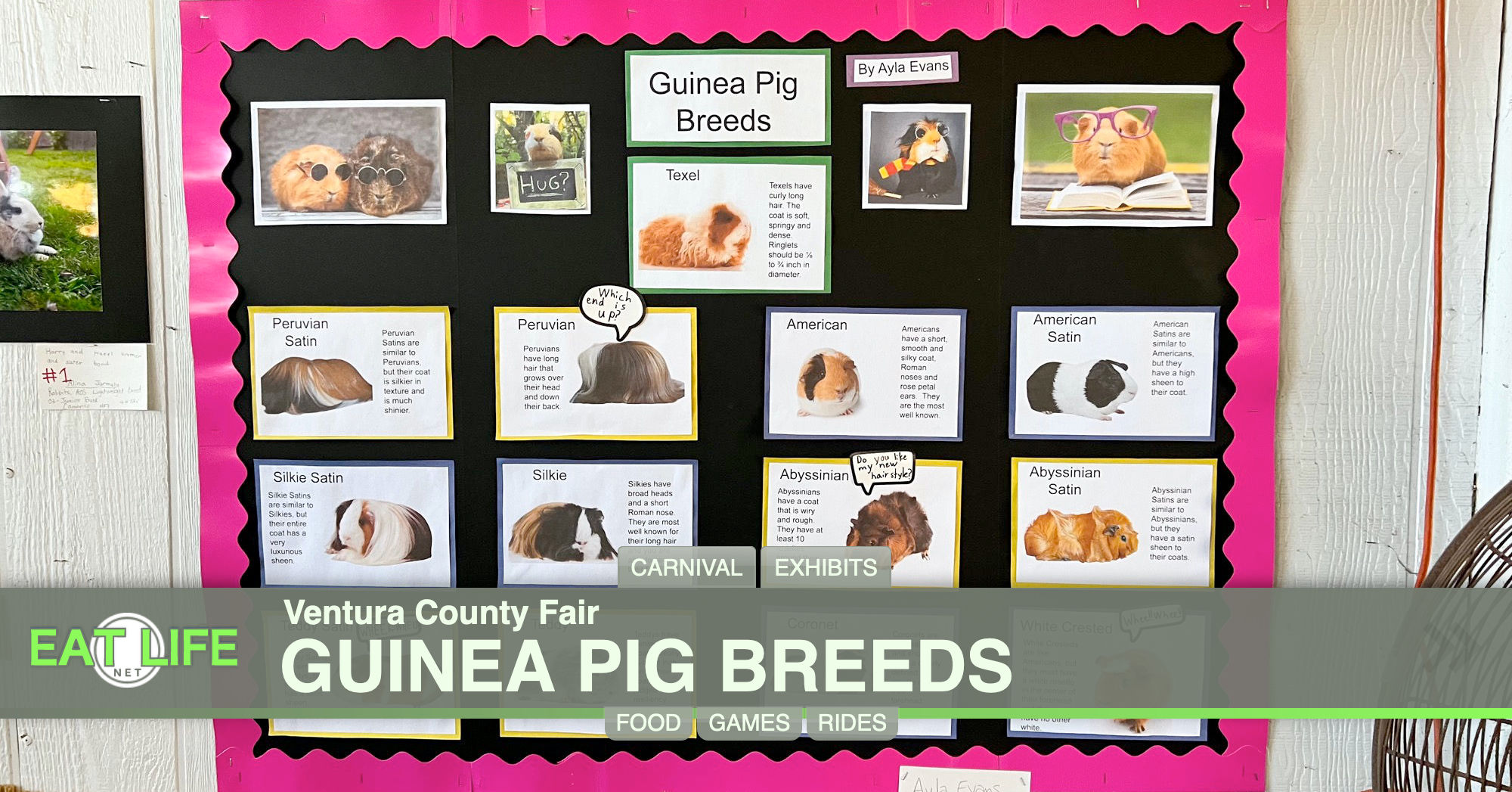Uncle Leo's Barnyard
BARNYARD
Updated: October 2024
Posted: September 2022

Guinea Pig Breeds
- Texel
Texels have curly long hair. The coat is soft, springy and dense. Ringlets should be 1/8 to 3/4 inch in diameter - Peruvian Satin
Peruvian Satins are similar to Peruvians, but their coat is silkier in texture and is much shinier - Peruvian
Peruvians have long hair that grows over their head and down their back - American
Americans have a short smooth and silky coat, Roman noses and rose petal ears. They are the most well known - American Satin
American Satins are similar to Americans, but they have a high sheen to their coat - Silkie Satin
Silkie Satins are similar to Silkies, but their entire coat has a very luxurious sheen - Silkie
Silkies have broad head and a short Roman nose. They are most well known for their long hair and you are able to see their face - Abyssinian
Abyssinians have a coat that is wiry and rough. They have at least 10 rosettes around their whole body - Abyssinian Satin
Abyssinian Satins are similar to Abyssinians, but they have a satin sheen to their coats - Teddy Satin
Teddy Satins are similar to Teddys, but their coat has a satin sheen - Teddy
Teddys have dense, kinky coats, ideally 3/4 of an inch long. Their coats are judged on resiliency - Coronet
Coronets are long haired and should have a clearly defined rosette on their forehead - White Crested
White Cresteds are like Americans, but they must have a white rosette in the center of their forehead and they must have no other white
The guinea pig or domestic guinea pig, also known as the cavy or domestic cavy, is a species of rodent belonging to the genus Cavia in the family Caviidae. Breeders tend to use the word cavy to describe the animal, while in scientific and laboratory contexts, it is far more commonly referred to by the common name guinea pig.Guinea Pig:
- Despite their common name, guinea pigs are not native to Guinea, nor are they closely related biologically to pigs, and the origin of the name is still unclear
- They originated in the Andes of South America
- Studies based on biochemistry and hybridization suggest they are domesticated animals that do not exist naturally in the wild, descendants of a closely related cavy species such as C. tschudii
- They were originally domesticated as livestock for a source of meat, and are still consumed in some parts of the world
In Western society, the guinea pig has enjoyed widespread popularity as a pet since its introduction to Europe and North America by European traders in the 16th century. Their docile nature, friendly responsiveness to handling and feeding, and the relative ease of caring for them have made guinea pigs a continuing popular choice of household pet.
- Organizations devoted to the competitive breeding of guinea pigs have been formed worldwide. Many specialized breeds, with varying coat colors and textures, are selected by breeders.
- Guinea pigs can learn complex paths to food, and can accurately remember a learned path for months
- Their strongest problem-solving strategy is motion
- While guinea pigs can jump small obstacles, they cannot jump very high
- Most of them are poor climbers, and are not particularly agile
- They startle easily, and when they sense danger either freeze in place for long periods, or run for cover with rapid, darting motions. Larger groups of startled guinea pigs "stampede", running in haphazard directions as a means of confusing predators.
- When happily excited, guinea pigs may (often repeatedly) perform little hops in the air (a movement known as "popcorning"), analogous to the ferret's war dance, and also similar to rabbit happy hops
- Guinea pigs are also good swimmers,[41] although they do not like being wet and infrequently need bathing
- Like many rodents, guinea pigs sometimes participate in social grooming, and they regularly self-groom
- Guinea pig eyesight is not as good as that of a human in terms of distance and color, but they have a wider angle of vision (about 340 degrees) and see in partial color (dichromacy)
- They have well-developed senses of hearing, smell, and touch
- Guinea pigs have developed a different biological rhythm from their wild counterparts, and have longer periods of activity followed by short periods of sleep in between. Activity is scattered randomly throughout the day; aside from an avoidance of intense light, no regular circadian patterns are apparent.
Guinea pigs do not generally thrive when housed with other species. Larger animals may regard guinea pigs as prey, though some dogs and cats can be trained to accept them. Opinion is divided over the cohousing of guinea pigs and rabbits.
- Vocalization is the primary means of communication between members of the species
- A "wheek" is a loud noise, the name of which is onomatopoeic, also known as a whistle. An expression of general excitement
- A bubbling or purring sound is made when the guinea pig is enjoying itself, such as when being petted or held
- A rumbling sound is normally related to dominance within a group, though it can also come as a response to being scared or angry
- Chutting and whining are sounds made in pursuit situations, by the pursuer and pursuee, respectively
- A chattering sound is made by rapidly gnashing the teeth, and is generally a sign of warning
- Squealing or shrieking is a high-pitched sound of discontent, in response to pain or danger
- Chirping, a less common sound, likened to bird song, seems to be related to stress or discomfort, or when a baby guinea pig wants to be fed
- The guinea pig's natural diet is grass; their molars are particularly suited for grinding plant matter and grow continuously throughout their life. Guinea pigs benefit from a diet of fresh grass hay, such as timothy hay, in addition to food pellets which are often based on timothy hay.
A number of plants are poisonous to guinea pigs, includingadditionally, any plant which grows from a bulb (e.g., tulip or onion) is normally considered poisonous
- bracken
- bryony
- buttercup
- charlock
- deadly nightshade
- foxglove
- hellebore
- hemlock
- ivy
- lily of the valley
- mayweed
- monkshood
- oak tree leaves
- privet
- ragwort
- rhubarb
- speedwell
- toadflax
- wild celery.
- Males (boars) reach sexual maturity in 3–5 weeks. Similarly, females (sows) can be fertile as early as 4 weeks old, and can carry litters before they are fully-grown adults. A sow is able to breed year-round (with spring being the peak). A sow can have as many as five litters in a year. Newborn cavy pups are well-developed with hair, teeth, claws, and partial eyesight. The pups are immediately mobile and begin eating solid food immediately, though they continue to suckle. Sows can once again become pregnant 6–48 hours after giving birth.
Guinea pigs do not generally thrive when housed with other species. Larger animals may regard guinea pigs as prey, though some dogs and cats can be trained to accept them. Opinion is divided over the cohousing of guinea pigs and rabbits.





